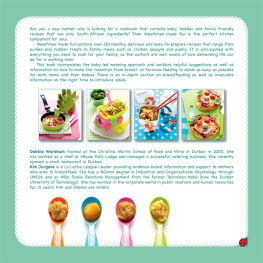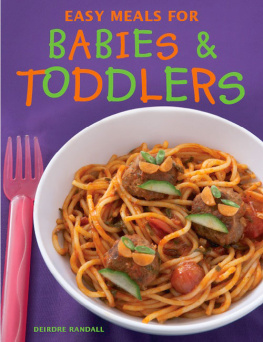
Published in 2014 by Struik Lifestyle
(an imprint of Random House Struik (Pty) Ltd)
Company Reg. No 1966/003153/07
Wembley Square, Solan Road,
Cape Town 8001 South Africa
PO Box 1144 Cape Town 8000 South Africa
First edition published in 2014 by Struik Publishers
Copyright in published edition: Random House Struik (Pty) Ltd 2014
Copyright in text: Debbie Wareham and Kim Jurgens 2014
Copyright in photographs: Random House Struik (Pty) Ltd 2014;
except photos on : iStockphoto/dszc;
: iStockphoto/idal;
: iStockphoto/Kenishirotie;
: iStockphoto/Fertnig;
: iStockphoto/shalamov
ISBN 978-1-43230-212-2 (Print)
ISBN 978-1-43230-377-8 (ePub)
ISBN 978-1-43230-378-5 (PDF)
All rights reserved. No part of this publication may be reproduced, stored in a retrieval system or transmitted, in any form or by any means, electronic, digital, mechanical, photocopying, recording or otherwise, without the prior written permission of the publishers and the copyright owner(s).
Publisher: Linda de Villiers
Managing editor: Cecilia Barfield
Design manager: Beverley Dodd
Editor and indexer: Anja Grobler
Designer: Helen Henn
Photographer: Sean Calitz
Stylist: Brita du Plessis
Stylist assistant: Bryony Mackay
Proofreader: Gill Gordon
Reproduction by Hirt & Carter Cape (Pty) Ltd
Also available in Afrikaans as Maaltye sonder moeite vir babas, kleuters en die hele gesin
ISBN 978-1-43230-213-9
www.randomstruik.co.za
We use the masculine pronoun he when referring to the baby or child. This is for convenience and clarity and does not reflect a preference for either sex.
Contents

Foreword

We have an interest in feeding our babies as healthily as possible. We believe that teaching them sound nutritional principles will allow them to make good food choices as they grow older and that this, along with exercise, will help them to stay in shape.
We try to live our lives by the principle that its fine to eat a bit of everything, as long as its in moderation. In essence a balanced diet consists of eating a variety of foods in moderation. Theres no need to forego the occasional bit of chocolate or ice cream as long as they dont replace the peas and potatoes.
This book is meant to be a companion to you in your kitchen as you go through the process of introducing solid foods to your baby and teaching him about variety and moderation. It will also assist you in keeping foods as close to their natural state as possible while bearing food safety in mind.
So whether you cook for lots of children in a day care setting, or youre a stay-at-home mom cooking up tasty morsels, or a working mom of five children who you try to get fed between work and homework and extra-murals, we hope you find a few good old tasty standbys here that are quick to prepare and easy on your pocket. Many of the dishes are suitable for the whole family so you dont end up cooking more than one meal a night. Children have small tummies that need frequent refilling so there are plenty of snack ideas too.
We would like to extend a special thanks to the late Christina Martin, from whom Debbie was fortunate enough to receive professional training in 2000. A few of the recipes in this book originated from some of Debbies favourite Christina Martin recipes. Christina sadly passed away in 2012, and we would like to express our sympathy to Bill, Michelle, Candice and the rest of her family.
Additionally, we have particularly enjoyed Annabel Karmels baby food cookbooks and the idea for a South African cookbook for South African children, using South African ingredients, was inspired by her work. Some of the recipes in her books got our stomachs rumbling and our thoughts going and led to the South Africanised versions that you will see on the following pages. Theyre quite different though and have Debbies special touch to them, as they evolved with her cooking with the ingredients available to moms in this country.
A few of the other recipes are family specialities that we loved as children and that our children love too. Enjoy this special journey with your children as they discover tastes and textures and likes and dislikes and remember, just because you dont like something, doesnt mean your children wont. Let them be adventurous; they might surprise you.
Debbie and Kim
Introduction

This is a cookbook that contains recipes for your baby and the whole family. It also includes information on breastfeeding and baby-led weaning. The process of introducing solid foods (herein referred to as solids) impacts on breastfeeding and some background information on breastfeeding is helpful and necessary. We know that some moms struggle with breastfeeding and despite their best efforts decide to formula-feed. Some moms formula-feed by choice. Others form part of the minority group who are unable to breastfeed because they are undergoing chemotherapy or have breast hypoplasia or untreated hormonal problems. The aim of this chapter is to provide practical tips for moms who are breastfeeding and not to make moms who are formula-feeding feel excluded.

Breastfeeding
Before the middle of its first year, a baby who is breastfed receives all of his nutritional needs for growth and development from breast milk. At around six months a baby starts to need the tastes and textures of, and some nutrition from solids but the saying before one, solids are just for fun is good to bear in mind. Breast milk continues to be the main source of nutrition for at least the first year of a babys life and is an additional source of nutrition after that.
Many moms report that although they dont wish to wean their baby at six months or a year they are pressured to do so and are told that there is no longer any benefit to breast milk. However, breast milk continues to provide nutritional benefits in addition to solids. Sometimes when a baby is ill he stops eating solids for a few days, but remains hydrated and soothed on breast milk.
How to make breastfeeding as easy as possible
Offering the breast as soon as possible after the baby is born, preferably within the first hour (referred to as the golden hour), makes starting and continuing the breastfeeding process much easier. Some babies are interested right away, while others need a little rest first.
Skin-to-skin contact gives a mom and her baby the opportunity to become accustomed to lying, sleeping, feeding and resting together. Of course, this is only possible if there arent any complications. If the baby cant be offered the breast immediately it doesnt mean that its the end of breastfeeding. It just means that a mom must try for extra skin-to-skin contact and offer access to the breast as much as she can after the complications have been dealt with. Include a skin-to-skin contact section in your birth plan and discuss this with your doctor beforehand to ensure that unless there are complications (which always takes priority to ensure that both mom and baby are well), that skin-to-skin contact will be made possible.
Next page










